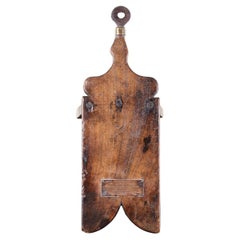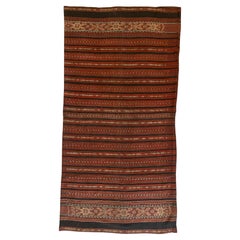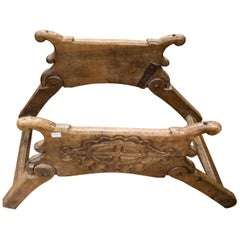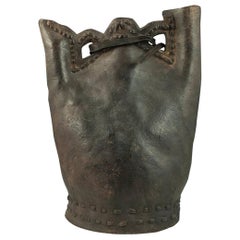16th Century Tribal Art
1
to
1
1
1
1
50
173
997
34
385
389
69
8
1
15
21
20
31
28
15
14
5
1
1
1
1
1
1
1
Period: 16th Century
A Rare and Historically Important Artefact Recovered from HMS Adventure in 1775
Located in London, GB
A Rare and Historically Important Artefact Recovered from HMS Adventure in 1775 after Captain James Cook’s Second Voyage to the Pacific
A ‘coconut husker’ made by a ship’s carpenter aboard HMS Adventure in the style and design of a Native Islander’s ethnographical ‘coconut husker’
An engraved and inscribed copper plaque:
A memento from
The Sandwich Islands
Coconut Husker used aboard
HMS Adventure
and recovered from
The Royal Dockyard Deptford
1775
Oak, iron, brass, copper, handmade iron screws
Fine rich colour and patina
England / Sandwich Island
18th Century
SIZE: 15.5cm high, 49.5cm long, 20cm wide (max) - 6¹⁄₈ ins high, 19½ ins long, 7⁷⁄₈ ins wide (max)
Provenance:
Found in a Scottish attic after centuries of lying hidden in a crate
Ex Private Scottish collection
Captain James Cook’s second voyage aboard the Resolution and accompanied by HMS Adventure set sail in July 1772. The discovery of the southern eight islands of the Sandwich Islands group was in 1775. The given name was chosen in honour of John Montagu, 4th Earl of Sandwich, First Lord of the Admiralty.
The copper plaque and inscription however should not be read as The Sandwich Islands ‘Owhyhee’ (The Hawaiian Islands) which were later discovered on January 18th, 1778, on Captain Cook’s third voyage. Rather the inscription refers to ‘South Sandwich Islands’ lying to the south east of South Georgia and only renamed later with the word ‘South’ to distinguish them from the ‘Sandwich Islands’ now known as the Hawaiian Islands.
Not withstanding during Cook’s second voyage he visited Easter Island, Tahiti, Society Islands, Niue, Tonga, New Hebrides, New Caledonia, Norfolk Islands, Palmerston Island and South Georgia. The crew onboard having been exposed to various types of ‘coconut huskers’ adapted those designs into the example we now see, having been rescued from HMS Adventure in 1775. A rare example of 18th century cross...
Category
American Antique 16th Century Tribal Art
Materials
Brass, Copper, Iron
Related Items
Ikat Textile from Flores Island, Indonesia
Located in Jimbaran, Bali
This Ikat textile originates from the Island of Flores, Indonesia. It is hand-woven using naturally dyed yarns via a method passed on through generations. This textile is tubular for...
Category
Indonesian Other 16th Century Tribal Art
Materials
Yarn
African Chieftain Chair from Oromo People in Ethiopia, circa Early 1900s
Located in Miami, FL
An early 20th century African chieftain chair from the Oromo people in the eastern part of Ethiopia. The Oromo chairs and seats are all identifiable ...
Category
Ethiopian Tribal 16th Century Tribal Art
Materials
Wood
Pre Columbian Rare Lambayeque Wood Figure
Located in London, GB
Pre columbian Lamabayeque wood figure Peru Circa 750 to 1375 AD
A rare standing figure of a deity with triangular tear drop shaped eyes holding a child,
Carved in very dense heavy hard wood
Measures: Height 14 inches, 36 cm weight, 1.5 kg approx
Ex collection of a Oxford Academic, reputed to have came from Pit rivers...
Category
Peruvian Antique 16th Century Tribal Art
Materials
Wood
Rare to Find Folk Art Jaguar Mask Found in Zitlala, Guerrero, Mid-20th Century
By G. None
Located in Guadalajra, Jal
This style of Tigre (Mexican colloquial for Jaguar) mask is from Zitlala, Guerrero, they are used on the feast day of the Holy Cross on May 3rd, 4th,
and 5th. As part of the activit...
Category
Mexican Folk Art 16th Century Tribal Art
Materials
Leather
H 7.88 in W 7.09 in D 3.94 in
African Carved Wooden Coffee Tray from the Gurage Zone in Ethiopia
Located in Miami, FL
An Ethiopian coffee tray carved out of a single piece of wood with round tray and handle resting on four legs, from the Gurage zone, named from t...
Category
Ethiopian Tribal 16th Century Tribal Art
Materials
Wood
Tulips, Arabesques and Turbans, Decorative Arts from the Ottoman Empire
Located in valatie, NY
Tulips, Arabesques and Turbans: Decorative Arts from the Ottoman Empire by Yanni Petsopoulos. Abbeville Press, 1982. First Edition hardcover no dust jacket. The author analyzes the p...
Category
American Vintage 16th Century Tribal Art
Materials
Paper
Archaic African Mortar Made from Ironwood
Located in Vienna, AT
This very massive, exceptional mortar is hand carved from a lovely rust couloured iron wood. It was made in the 19th century on the African continent, possibly in Ghana. The bowl's s...
Category
Ghanaian Archaistic Antique 16th Century Tribal Art
Materials
Wood
From the Rush Limbaugh Collection Korhogo Cloth from Ivory Coast of Africa
By Korhogo Tribe
Located in Asheville, NC
This is a hand spun, hand woven and hand painted cotton cloth for which an entire village takes part in its creation. Women of the Korhoga Tribe spin the cotton, while the men weave ...
Category
Primitive Antique 16th Century Tribal Art
Materials
Cotton
H 64.75 in W 101.25 in D 2.5 in
Rare Antique Zemmour Moroccan Berber Rug
Located in Milan, IT
A rare mixed technique Berber rug ascribed to the Zemmour people, located in the Moroccan Middle Atlas, originally used as a saddle cover - an item of great prestige among Berber tri...
Category
Moroccan Tribal Vintage 16th Century Tribal Art
Materials
Wool
Rare Tuareg Nomadic Boots
Located in Antwerp, BE
Tuareg nomadic people leather boots.
Category
Nigerien Folk Art Antique 16th Century Tribal Art
Materials
Leather
Ikat Textile from Sumba Island, Indonesia
Located in Jimbaran, Bali
This Ikat textile originates from the Island of Sumba, Indonesia. It is hand-woven using naturally dyed yarns via a method passed on through generations. ...
Category
Indonesian Other 16th Century Tribal Art
Materials
Yarn
Ikat Textile from Timor Island, Indonesia
Located in Jimbaran, Bali
This Ikat textile originates from the Island of Timor, Indonesia. It is hand-woven using naturally dyed yarns via a method passed on through generations. The dark blue foreground bri...
Category
Indonesian Other 16th Century Tribal Art
Materials
Yarn
Previously Available Items
16th Century Spanish Walnut and Wrought Iron Dromedary Saddle
Located in Valladolid, ES
One of a kind 16th century Spanish school dromedary saddle in carve walnut and wrought iron, in a very good condition with age and use, Its very difficult to find this pieces, it was...
Category
Spanish Gothic Antique 16th Century Tribal Art
Materials
Wood
16th Century Leather Tribal Ottoman Water Flask 'Matara', Turkey
Located in Point Richmond, CA
16th century leather tribal ottoman water flask (Matara), Turkey.
The round body of this matara tapers into two spouts: on the left is a small stitched ...
Category
Turkish Tribal Antique 16th Century Tribal Art
Materials
Leather
Free Shipping
H 12.25 in W 9 in D 5 in
Large Reconstructed Elephant Bird's Egg
Located in Schellebelle, BE
A large reconstructed elephant bird's egg,
Madagascar,16 century.
Restored.
Category
Malagasy Antique 16th Century Tribal Art
Materials
Eggshell
16th Century Hand Cross, Ethiopia
Located in New York, NY
An early iron hand cross from Northern Ethiopia, early to mid-16th century.
Ethiopian hand crosses are coveted by collectors of medieval art, religious art and tribal art for their beauty and variety of forms.
Ethiopia was probably the second country after Armenia to embrace the Christian faith. There is evidence that Christianity thrived in the country even in the 1st century and for most of the country's history since, the state religion has been Orthodox Christianity.
This elegant example is a Portugese-style elongated Hand cross. In 1541, a grandson of Vasco de Gama, Cristovao de Gama, arrived in Ethiopia on a crusade together with 400 musketeers at the behest of the Ethiopian Emperor and helped reverse the Muslim Invasion from the East. With them, the Portuguese brought engravings and crosses which greatly influenced Ethiopian art...
Category
Ethiopian Antique 16th Century Tribal Art
16th c. Hand Cross, Ethiopia
Located in New York, NY
An iron processional hand cross, Northern Ethiopia, 15th-17th century.
Ethiopian hand crosses are coveted by collectors of medieval art, religious art and tribal art for their bea...
Category
Ethiopian Antique 16th Century Tribal Art
Materials
Iron




